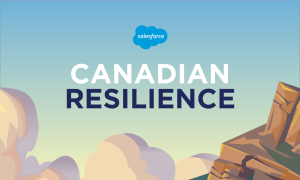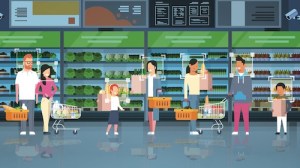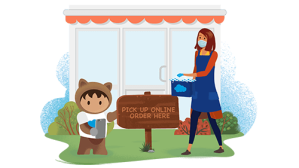How Canadian Retailers Are Supporting Shoppers Amidst the New Normal



Here's how retailers are responding with agility and resilience as they navigate dramatic shifts in category preferences, channel preferences, and consumer shopping behavior.

Salesforce Canada
This is a defining moment in retail. With COVID-19 creating an international emergency, the majority of Canadians have been sheltering in place for more than a month now. The result is a massive spike in demand for groceries and other household essentials alongside widespread concerns about safety from both customers and employees.
According to the Salesforce Q1 Shopping Index, social traffic on tablet devices has doubled since the third quarter of last year. You can imagine shoppers using the larger screen real estate of a tablet to answer critical questions such as: “Can I get what I need?”and more importantly, “Can I get it safely?”
Retailers are responding with agility and resilience as they navigate dramatic shifts in category preferences, channel preferences, and consumer shopping behavior. Here’s what every retailer can do to address the challenges and build trust:
Improve merchandise agility and visibility
Shoppers have cleared store shelves of items like hand sanitizer, bottled water, and toilet paper. Even bread and canned goods have been scarce. In fact, a recent report from Statistics Canada revealed 63% of Canadians are stocking up on essentials.
This included bathroom tissue, which skyrocketed up 241% compared with the same time last year, and overall 16% higher grocery sales during the week of March 11 compared with the busiest shopping week of the year in 2019.
Consider the following best practices as you shift into overdrive to address sudden, unexpected shifts in product preferences:
-
Ramp up efforts to replenish. As stockroom inventory dwindles, stores seek to bring in more product as fast as possible. In an interview with the Globe and Mail, the president of food distributor Sysco Canada said his firm was pivoting from restaurant and hospitality customers to to help grocers keep their inventories high. Other distributors, like Gordon Food Service and Flanagan Foodservice, are doing the same thing.
-
Ensure every shopper has access to essentials. Some retailers have implemented purchase limits on high-demand items, from paper products to canned goods to baby supplies. Price gouging is another threat, and Amazon is cracking down on sellers setting outrageous price points for high-need items.
-
Refactor manufacturing and supply chain. Brands such as Crocs, Canada Goose, and New Balance have taken advantage of their scale, leverage, and agility to provide safety and protective products to healthcare and other professionals on the front line.Others, such as Nobis and Knix, are donating or raising funds to procure PPE to fight COVID-19.
-
Communicate your efforts to shoppers. Retailers added notices to their websites, or to their doors, to reassure customers supplies would continue to arrive and to explain any other new policies, such as Amazon’s prioritizing shipments of essentials over less-necessary items.
Adopt contactless engagement
As shoppers try to stay home, demand for delivery has skyrocketed. Instacart, Walmart Grocery, and Shipt saw 218%, 160%, and 124% increases, respectively, in average daily downloads compared to the previous month. And, generations traditionally not used to shopping this way, such as the elderly, are also getting on board with new technology.
Expand contactless payment and delivery services as well as other ways for shoppers to get groceries or other purchases without having to navigate store aisles or come into close contact with people. Indigo Books & Music, for example, has shut down its retail stores but is offering contactless curbside pickup for all online purchases.
-
Provide contactless payment. Montreal-based Mobeewave recently introduced new features to its service that will allow retailers to process contactless payments by tapping a card or online wallet onto the back of an NFC-enabled mobile device. The need for special card readers or other speciality hardware can create more frustration for consumers who are already inconvenienced.
-
Offer more delivery options. The CBC noted that many local Canadian farmers have taken money they would have normally allocated towards trade shows and expanded home delivery of everything from milk to fresh meat. This has meant hiring not only delivery drivers but more packers in some cases. Companies can also add delivery times to meet increased demand.
-
Accelerate Buy Online Pickup in Store (BOPIS). Shoppers who need items fast can see if they are available in a nearby store, claim them and pay online, and pick up the items at the store. Just look at Loblaw Inc., which is building an automated picking facility to support its PC Express BOPIS service. This eliminates in-person visits to multiple stores in search of a hard-to-find item and unnecessary contact at the store. Shoppers simply walk in and pick up their orders or can even take advantage of curbside delivery.
-
Update customers on new options. Clearly communicate available services. Grocery stores managing online delivery services can keep customers informed and respond to inquiries quickly using Salesforce Care for Employee and Customer Support.
Set new policies to ensure shopper — and employee — safety
The unprecedented threat to health and safety calls for never-before-needed measures in brick-and-mortar stores. To protect the most vulnerable, consider the following practices:
-
Institute specific shopping times for the elderly or immunocompromised. Welcome these individuals in when the store first opens in the morning, when it is cleanest and fully stocked.
-
Implement safety protocols. Limit the number of people in the store at one time and instruct shoppers to remain six feet apart. Some grocery stores have put tape on the ground to mark where shoppers should stand while waiting to enter or check out.
-
Step up cleaning efforts. Modify open hours to facilitate regular deep cleaning. Install hand sanitizer dispensers throughout the store and encourage shoppers and employees to use them.
Respond with empathy and creativity
Grocery and pharmacy workers have become frontline heroes in this pandemic, especially those who come into contact with the public, such as cashiers and stockers. Warehouse workers also put their health on the line. Leaders can support them in multiple ways:
-
Increase compensation for hourly employees. Acknowledge their hard work, and their risk of exposure, with a tangible raise in pay. Sobeys, for instance, has launched what it calls its Heroes Pay Program, which will provide an extra $50 a week to all employees. Those working more than 20 hours a week will get a $2 per hour premium.
-
Prioritize worker health and safety. Increase the cleaning cadence for warehouses and other workspaces and provide protective equipment if possible. Bolster leave policies to encourage sick workers to stay home and fully recover. Learn other ways to enhance employee wellbeing with Camp B-Well (Trailhead).
-
Be transparent as your response evolves. Leverage Quip to establish a crisis strategy and craft templates for communications. Share changes in policy to all stakeholders and encourage feedback. H-E-B established a coronavirus hotline for employees in need of information or assistance.
-
Pledge no layoffs like RBC and Chubb Insurance. Give employees peace of mind by committing to no significant layoffs for 90 days for salaried, non-salaried, and hourly employees alike, in order to show dedication to your workforce.
Next steps and resources
These are challenging times for the retail industry. While digital has seen very healthy growth in the first quarter, it won’t come close to offsetting the seismic drop in physical foot traffic. Those leaders who adapt to the challenges created by the health crisis are attracting new customers and cementing lifelong relationships. Learn more about the Salesforce Care Solution, which helps you communicate with customers and employees directly or on social media.
Our Leading Through Change series provides thought leadership, tips, and resources to help business leaders manage through crisis. Check out some of our most recent articles:
-
Find out how retailers are connecting with digital-only customers
-
Get five tips to update your site faster in a time of crisis
-
See five ways we’re helping our employees navigate work now
For more Leading Through Change, click here.

















